Proposed in 2005 by Jorge E. Hirsch, a physicist at the University of California, San Diego, the h-index quantifies scientific output as a single statistic based on both the number and impact of a researcher’s publications.1 An h-index of 40 means that a scientist has published 40 papers that each have at least 40 citations. The h-index conveys the broad impact of work over time and never decreases. It is supposed to be insensitive to the extremes of either non-cited papers or “one-hit wonders.” Authors with similar h-index values are theoretically comparable in overall scientific influence, even if their numbers of papers or citations are very different.
Unlike the journal impact factor, the h-index measures accomplishment, not journal performance. It can be used for groups such as scientific facilities or countries (e.g., to compare United States vs. European Union scientists). Hirsch notes that the h-index in biosciences runs higher than in physics. Since different disciplines have different citation patterns, it should be used to compare only scientists of similar professional age working in similar disciplines.
Critics say that h-index does not differentiate between active and inactive scientists or between timely and outdated works. Complementary indices developed by Hirsch and others correct for bias toward researchers with longer careers and more papers; sensitivity to highly cited papers; number of co-authors; and self-citation.
Are you curious about your own h-index? Three HSLS resources—ISI Web of Science, Scopus, and Google Scholar—include the necessary citation data, but finding it is the easiest in ISI Web of Science:
1. In Search (not Cited Reference Search), search for yourself.
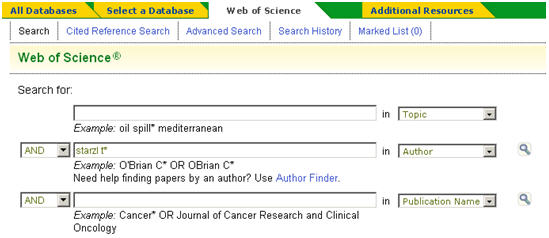
2. In the search results, click on “Create Citation Report.”
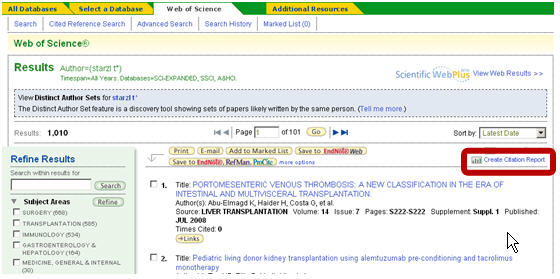
3. In the Citation Report, h-index is listed to the right of the bar graphs.
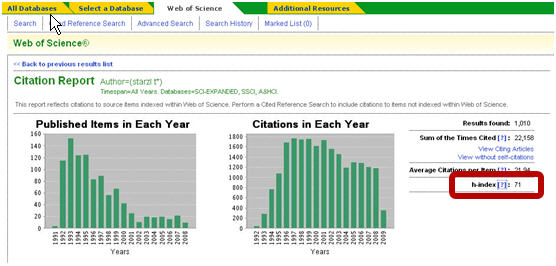
Like the journal impact factor, the h-index is vulnerable to citation data flaws. It will be inflated if articles by multiple authors with the same name are not differentiated. Factors that lower it include inaccurate citations, publication in journals not included in ISI Web of Science, and publications other than journal articles.
In separate studies, h-index ’s validity has been variously confirmed by positive correlations with raw citation counts, awarding of major postdoctoral fellowships, and peer judgments. Still, absent definitive validation studies, the h-index, like the journal impact factor, should be kept in perspective as just one component in the assessment of a scientific career.
1 Hirsch J.E. An index to quantify an individual’s scientific research output. Proc Natl Acad Sci USA. 102, no. 46 (2005):16569-16572.
~ Patricia Weiss

 The Health Sciences Library System (HSLS) is pleased to announce expanded library service at the new Children’s Hospital of Pittsburgh (CHP) of UPMC in Lawrenceville. Located on the sixth floor of the hospital in the center of family and clinical activity, the bright and spacious Family Resource Center includes separate areas for the Moulis Children’s, Young Adult, and Family Health Libraries as well as the Blaxter Medical Library.
The Health Sciences Library System (HSLS) is pleased to announce expanded library service at the new Children’s Hospital of Pittsburgh (CHP) of UPMC in Lawrenceville. Located on the sixth floor of the hospital in the center of family and clinical activity, the bright and spacious Family Resource Center includes separate areas for the Moulis Children’s, Young Adult, and Family Health Libraries as well as the Blaxter Medical Library.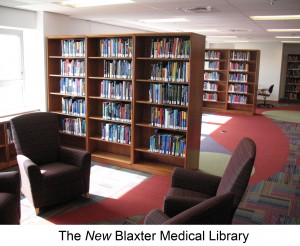 Also available for clinicians’ use is the addition of a wireless conference room, private study carrels, and a separate open space with seven desktop computers. New clinical library services also include classes on searching bibliographic databases such as PubMed, CINAHL and Embase, EndNote training, and HSLS orientation, with other classes to be added over time. Individual search consultations continue to be available on request.
Also available for clinicians’ use is the addition of a wireless conference room, private study carrels, and a separate open space with seven desktop computers. New clinical library services also include classes on searching bibliographic databases such as PubMed, CINAHL and Embase, EndNote training, and HSLS orientation, with other classes to be added over time. Individual search consultations continue to be available on request.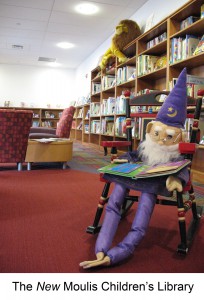 family members who need a temporary office while their child is hospitalized. Adults can also relax in a comfortable lounge with a fireplace and solarium stocked with recreational reading materials. CHP features wireless Internet connection throughout, for both family and clinical use. The Moulis Children’s Library continues to offer high-quality children’s books and audiobooks for infants through early readers, while the Young Adult Library houses the latest in young adult fiction and non-fiction books and audiobooks along with computers and a flat-screen television. At the Family Health Library, families can research their child’s condition, either by browsing our extensive collection or working with an HSLS medical librarian to search for more detailed information.
family members who need a temporary office while their child is hospitalized. Adults can also relax in a comfortable lounge with a fireplace and solarium stocked with recreational reading materials. CHP features wireless Internet connection throughout, for both family and clinical use. The Moulis Children’s Library continues to offer high-quality children’s books and audiobooks for infants through early readers, while the Young Adult Library houses the latest in young adult fiction and non-fiction books and audiobooks along with computers and a flat-screen television. At the Family Health Library, families can research their child’s condition, either by browsing our extensive collection or working with an HSLS medical librarian to search for more detailed information.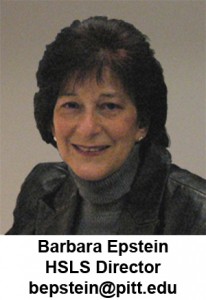 Like most other programs in the University and the health center, HSLS has been adversely affected by the ongoing global economic crisis. Budget support has declined, leading to difficult decisions about collections and services.
Like most other programs in the University and the health center, HSLS has been adversely affected by the ongoing global economic crisis. Budget support has declined, leading to difficult decisions about collections and services.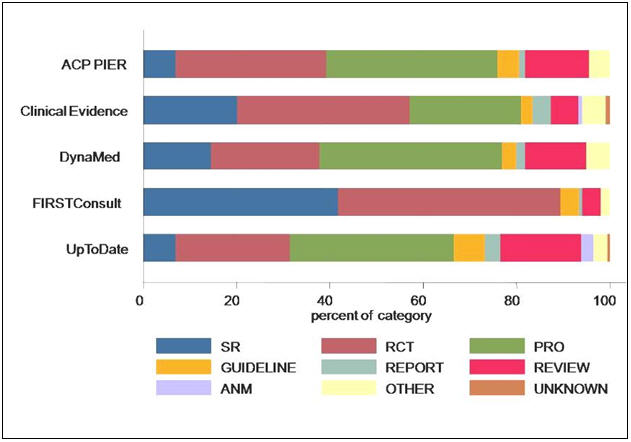

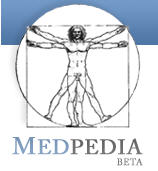
 In March, Ansuman Chattopadhyay, head of the Health Sciences Library System’s Molecular Biology Information Service, traveled to Delhi, India, to lecture at the International Workshop on Psychiatric Genetics, Ethics and Related Methodological Issues. In addition to Chattopadhyay, other presenters included faculty from the University of Pittsburgh, University of Pennsylvania and University of Virginia, as well as the director of India’s Centre for DNA Fingerprinting and Diagnostics (CDFD).
In March, Ansuman Chattopadhyay, head of the Health Sciences Library System’s Molecular Biology Information Service, traveled to Delhi, India, to lecture at the International Workshop on Psychiatric Genetics, Ethics and Related Methodological Issues. In addition to Chattopadhyay, other presenters included faculty from the University of Pittsburgh, University of Pennsylvania and University of Virginia, as well as the director of India’s Centre for DNA Fingerprinting and Diagnostics (CDFD). The AMA Manual of Style: A Guide for Authors and Editors, 10th edition, is now available online to HSLS users. The online edition contains information needed by medical and scientific researchers, writers, and editors to produce well-organized, clear, readable, and authoritative manuscripts.
The AMA Manual of Style: A Guide for Authors and Editors, 10th edition, is now available online to HSLS users. The online edition contains information needed by medical and scientific researchers, writers, and editors to produce well-organized, clear, readable, and authoritative manuscripts. Pat Bookamyer, administrative assistant in the Health Sciences Library System’s (HSLS) Office of the Director, retired from the University in April after almost 20 years. In her role as administrative assistant, she utilized her many skills in support of the Director and the operation of HSLS. Bookamyer also volunteered to serve as HSLS United Way representative for 19 years.
Pat Bookamyer, administrative assistant in the Health Sciences Library System’s (HSLS) Office of the Director, retired from the University in April after almost 20 years. In her role as administrative assistant, she utilized her many skills in support of the Director and the operation of HSLS. Bookamyer also volunteered to serve as HSLS United Way representative for 19 years.